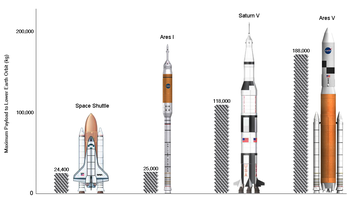Super heavy-lift launch vehicle
A super heavy-lift launch vehicle is a rocket that can lift to low Earth orbit a "super heavy payload", which is defined as more than 50 metric tons (110,000 lb)[1][2] by the United States and as more than 100 metric tons (220,000 lb) by Russia.
After the Saturn V's successful Apollo program and the N1's failures, the Soviets' Energia launched twice in the 1980s, once bearing the Buran spaceplane.
The next two decades saw multiple concepts drawn out once again, most notably Space Shuttle-derived vehicles and Rus-M, but none were built.
^D Includes mass of Orion spacecraft, European Service Module, Interim Cryogenic Propulsion Stage, and propellant for translunar injection.
[52] Yenisei,[53] a super heavy-lift launch vehicle using existing components instead of pushing the less-powerful Angara A5V project, was proposed by Russia's RSC Energia in August 2016.
[58] Blue Origin has plans for a project following their New Glenn rocket, termed New Armstrong, which some media sources have speculated will be a larger launch vehicle.
As part of the Soviet crewed lunar project to compete with Apollo/Saturn V, the N1 rocket was secretly designed with a payload capacity of 95 t (209,000 lb).
[64] The only Universal Rocket to make it past the design phase was the UR-500 while the N1 was selected to be the Soviets' HLV for lunar and Martian missions.
[66] The General Dynamics Nexus was proposed in the 1960s as a fully reusable successor to the Saturn V rocket, having the capacity of transporting up to 450–910 t (990,000–2,000,000 lb) to orbit.
[71] Based on the recommendations of the Stafford Synthesis report, First Lunar Outpost (FLO) would have relied on a massive Saturn-derived launch vehicle known as the Comet HLLV.
[74] A 1962 design proposal, Sea Dragon, called for an enormous 150 m (490 ft) tall, sea-launched rocket capable of lifting 550 t (1,210,000 lb) to low Earth orbit.
[77] SpaceX Interplanetary Transport System was a 12 m (39 ft) diameter launch vehicle concept unveiled in 2016.

